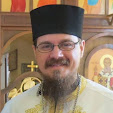Necessarily, we must understand the likeness of humanity to God in tension with God’s absolute transcendence. Dynamically, mysteriously, “man, this mortal, passible, short-lived being [is] the image of that nature which is immortal, pure, and everlasting,” as St. Gregory of Nyssa writes in his work On the Making of Man. It is difficult to understand how the one could image the other.
 |
| 11th century mosaic icon of St. Gregory of Nyssa |
Mutability inherent in bodily human nature negatively manifested itself in the Fall. “That which was made ‘in the image’ is one thing and that which is now manifested in wretchedness is another,” writes Gregory. Perhaps consequently, Gregory appears to deny that the bodily side of human nature participates in the image of God. Before I put forth a disagreement with this conclusion, a reminder of Gregory’s humility in expressing his ideas: “we … do not set forth that which occurs to our mind authoritatively, but will place it in the form of a theoretical speculation before our kindly hearers.” Neither do I claim my disagreement with Gregory is authoritative.
Gregory sees in the division of sexes and the plurality of human nature a “departure from the Prototype: for ‘in Christ Jesus,’ as the apostle says, ‘there is neither male nor female’" (Gal 3: 28). In this he fails to perceive the image of God in the human body, it seems to me. He goes so far as to suggest that God created man in His image without sex and then added the distinction of sex, thus somewhat removing man from the image of God. He writes, “He devised for His image the distinction of male and female, which has no reference to the Divine Archetype.” Gregory identifies, reasonably enough, sexual distinction as a necessary attribute of the physical nature of humanity – for reproduction – but then suggests that it did not belong to man as created in the image of God. God added it later. First, God created “man” without this distinction. Could we even call this hypothetical sexless creature human?
 |
| Tertullian |
The differences between persons and their notwithstanding capacity for union is an image of the plurality of persons and the oneness of essence in God. God said, “Let us make man in our image” (Gen 1:26). If God, then, refers to Himself in the plural, an entirely singular nature of man would be an imperfect image of God. The two and one matrimonial union (or three and one if we consider the oneness of the family with children) becomes an icon of the three and one God. In this sense, the image of God is embodied, male and female.
Human nature is an image of God in that it is relational, and in every way that it is good, because God is the all-good One. He is Goodness Himself. As Gregory writes, “He creates man for no other reason than that He is good… Man was made ‘in the image of God,’ [which] is the same as to say that He made human nature participant in all good.” Among the many good attributes humanity shares with God, Gregory finds the image of God preeminently shown forth in that “we are free.” By this freedom, we, who are sinners, can choose to partake of “the divine nature” (2 Pet 1:4) freely offered by God from the moment of our creation until now. Because we are free, union with God is possible because virtue is possible and we can accept God’s mysterious and sacramental grace through the Church. Indeed, God offers this grace even in the moment of creation, at which, as Gregory writes, by God’s foreknowledge, “the whole race was spoken of as one man.”













No comments:
Post a Comment